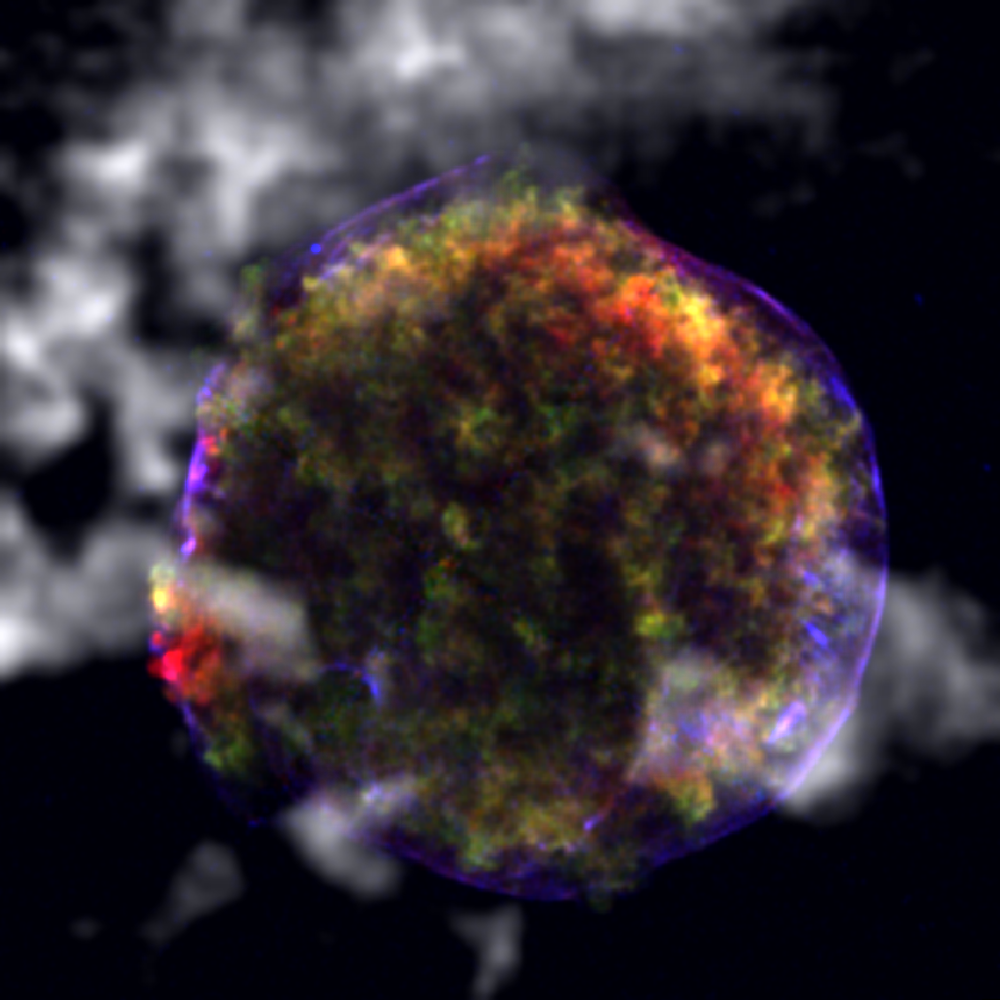News
Expanding molecular bubble unveiling the mysterious origin of Tycho's supernova remnant
An international team of astronomers from China, UK, and Canada has discovered an expanding molecular gas bubble surrounding the remnant of Tycho’s supernova with the IRAM 30-meter telescope. This is the very first unambiguous detection of an expanding bubble driven by the progenitor star of a Type Ia supernova, and an important clue to understanding the mysterious origin of this historical supernova and its remnant.
As “standard candles” for measuring distances to distant galaxies, Type Ia galaxies play a crucial role in studying the expansion of the Universe. Despite decades of study, the nature of these systems remains a puzzle. Currently, there are two competing ideas for their formation: the single-degenerate scenario, in which a white dwarf accretes matter from a nearby normal star, grows too massive to support itself and explodes as supernova, and the “double degenerate” scenario, in which two white dwarfs orbit one another and eventually merge to produce a supernova explosion.
 |
| Tycho’s supernova remnant in a molecular cloud bubble. Grey: molecular gas traced by carbon monoxide emission observed with IRAM 30-meter telescope (credit: P. Zhou); color: X-ray emission observed with the Chandra X-ray Observatory (credit: NASA/CXC/Rutgers/J.Warren & J.Hughes et al.). |
Closer to home, in the Milky Way, the best-studied type Ia supernova is the remnant of Tycho’s supernova, named after Danish astronomer Tycho Brahe who studied this particular phenomenon in great detail. At 2.5 kpc distance and spanning 6pc on the sky, Tycho’s Supernova Remnant (SN 1572) is the debris of a historical Type Ia supernova exploded back in 1572. Ancient astronomers in China, Europe and Korea recorded it as a "guest star’" or "new star", which suddenly appeared at late autumn and was so bright to be visible in daylight.
Despite several dedicated studies of SN 1572 across the electromagnetic spectrum, the origin of the event remained unclear until now. “If Tycho’s supernova resulted from a single-degenerate (a white dwarf plus star) system, we may have an opportunity to find a bubble blown out by the strong wind launched from the white dwarf while it accreted matter from the companion star, ” says Dr. Ping Zhou from the School of Astronomy and Space Science at Nanjing University, China, who led the research team, “and we indeed find such an expanding carbon monoxide bubble surrounding Tycho's supernova remnant with a dedicated IRAM observation”.
 |
| 3-dimensional (sky positions and Doppler velocity) visualization of the expanding molecular bubble surrounding Tycho’s SNR (Credit: P. Zhou) |
“This discovery constitutes supportive evidence for the single-degenerate scenario, since a double-white dwarf system is not likely to generate winds powerful enough to create such a bubble,” comments Prof. Yang Chen (Nanjing University, China), co-author of the discovery paper. The expanding molecular bubble provides key boundary conditions on the supernova progenitor system. To create such a molecular bubble shell, the progenitor system must have launched a fast outflow at a speed of hundreds of kilometer per second. Now we are watching the supernova blast wave quickly overtaking the molecular bubble shell from the bubble interior.
Type Ia supernovae are usually expected to appear in a low density interstellar medium, and therefore the interaction of Tycho's supernova remnant with the surrounding molecular clouds is an unexpected phenomenon.
“Actually, SN 1572 may be so far the only Type Ia supernova remnant known to be associated with a molecular cloud, ” says coauthor Dr. Zhi-Yu Zhang from the University of Edinburgh (UK). “There might be more wind blown molecular gas bubbles waiting to be discovered among the known Type Ia supernova remnants in our Milky Way galaxy and beyond. Finding them (or not) will help address the on-going puzzle about the origin of Type Ia supernovae” says Prof. Samar Safi-Harb (University of Manitoba, Canada), co-author of the work.
More info :
This work has been recently published in Astrophysical Journal on July 20, 2016 and the molecular observations were carried out with the IRAM 30-meter telescope at Pico Veleta in Spain.
Reference: http://dx.doi.org/10.3847/0004-637X/826/1/34, http://arxiv.org/abs/1605.01284
Visualization tool of Figure 2: programed by Xing Lu https://github.com/xinglunju/tdviz
Contact: Ping Zhou, Nanjing University, China, email: pingzhou@nju.edu.cn



